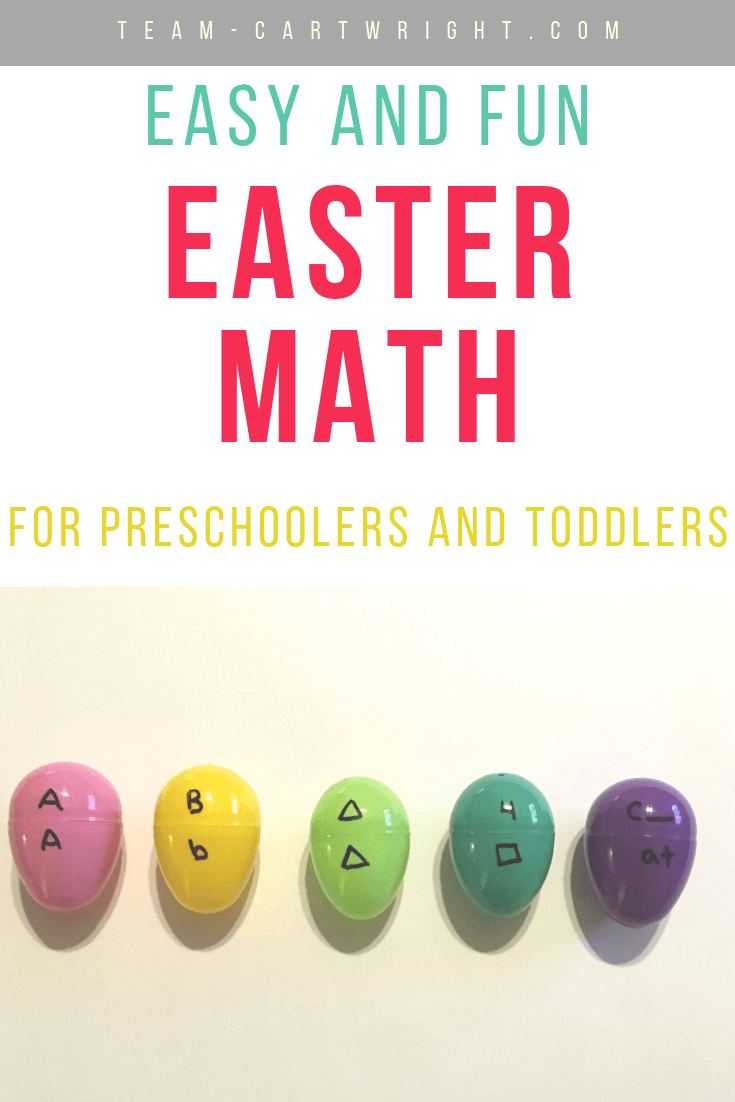Easter number sense games for preschoolers and toddlers
Some of my favorite learning activities are the ones I can set up for my kids then walk away from while they have fun. Yep, even STEM loving moms like to encourage their children to play by themselves.
I have found that you can take a lot of regular toys and turn them into math games. It is great one two levels.
One, you get to reignite interest in old toys. No need to buy anything new!
Two, you are teaching your kids how to use what they have AND that most objects can have multiple uses. This inspires
Since we are all about Easter right now, the only logical toys to use for math games are Easter eggs. (Trust me, Easter math is fun.)

What's In This Post?
Easter Number Sense Games
The materials for this STEM activity is pretty clear. You need plastic eggs, the kind that are in two separate pieces
I got my eggs at the Dollar Store, but Target and Amazon have them for pretty cheap.
You’ll want a dry erase marker too.
Why Does Number Sense Matter?
What is number sense? Kids need to learn how to count, that much we know for sure. But they need more than that.
Number sense is understanding that each number has a unique value, and those values can interact with each other. This understanding is the basis for all future math.
(Learn more about number sense and get easy activities: Simple Number Sense for Toddlers and Preschoolers)
Simple Matching
The first game is simple number matching. Write the same number on each part of the egg. Then mix them up and let your kids match the numbers back up!
This is a good one for toddlers just learning their numbers.
You can add to the challenge by changing up the colors of the eggs so the two halves might have the same number, but are not the same color. This forces your children to really look at the numbers and not just rely on the colors.
Value Matching
The next level is to work on recognizing that numbers have a distinct value. So write a number on one half of an egg and then draw that many dots on the other half.
The goal of this is to reinforce not only what the numbers are, but the values they represent.
Basic Addition
Ben is working on this as a preschooler. Write a number on one half of an egg, then put a simple addition problem that adds up to that number on the other half. Instant math challenge.

Basic Subtraction
Subtraction can be harder to understand, especially because the order the numbers are in is more important. (For example, 2+3 is the same as 3+2. But 3-2 is very different from 2-3.) Start small and build to harder questions.
More Activities To Try
Number Memory Game
If you don’t want to write on your eggs you can still create a fun game.
Write numbers all over a poster board or pieces of paper. Then cover them up with plastic egg halves.
Your children can take turns looking under two eggs at a time. If the numbers match they can keep the egg pieces and go again!
Shape Matching
Don’t think you have to stick to numbers! Try drawing shapes on each half of the egg and having your children match them up.
Take it a step further and draw a shape on one half of an egg, and on the other put the number of sides that shape has. So a match would be 3 and a triangle, or 4 and a rectangle.

Even More Learning Games
Now the focus of this series is STEM, but don’t be afraid to take this idea and work on other skills with it!
Write letters on your eggs. Match just the letters or work on matching capital letters with their corresponding lower case letters.
You can match site words. Or work on rhyming. There are a surprising number of uses for plastic Easter eggs.

10 Days of Easy Easter STEM
Don’t forget to come back
10 Days of Easter STEM
10 Days of Easy Easter STEM!
STEM
Remember that STEM stands for:
Science: Where toddlers and preschoolers learn to observe and start to understand how the world around them works. This is where kids learn to ask questions.
Technology: Where children learn to use the tools that help them explore this world. Yes, computers and screens are a part of this, but they are not the whole story. Simple tools like scissors and magnifying glasses are a part of it too.
Engineering: Where children start to explore how things work. It’s building things like towers, and it is taking things apart to see how they fit together.
Math: Where children learn counting and number recognition. This is where we lay the groundwork of number sense. Number sense is the basic understanding that numbers have individual values and these values interact.















